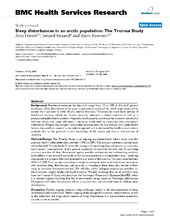| dc.description.abstract | Background Prevalence estimates for insomnia range from 10 to 50% in the adult general population. Sleep disturbances cause great impairment in quality of life, which might even rival or exceed the impairment in other chronic medical disorders. The economic implications and use of health-care services related to chronic insomnia represent a clinical concern as well as a pronounced public health problem. Hypnotics are frequently prescribed for insomnia, but alcohol and over-the-counter sleep aids seem to be more widely used by insomniacs than prescription medications. Despite the complex relationship between insomnia and physical and mental health factors, the condition appears to be underrecognized and undertreated by health care providers, probably due to the generally limited knowledge of the causes and natural development of insomnia. Methods/Design The Tromsø Study is an ongoing population-based cohort study with five previous health studies undertaken between 1974 and 2001. This protocol outlines a planned study within the sixth Tromsø Study (Tromsø VI), aiming at; 1) describing sleep patterns in a community-based sample representative of the general population of northern Norway, and 2) examining outcome variables of sleep disturbances against possible explanatory and confounding variables, both within a cross-sectional approach, as well as retrospectively in a longitudinal study – exploring sleep patterns in subjects who have attended two or more of the previous Tromsø studies between 1974 and 2009. First, we plan to perform a simple screening in order to identify those participants with probable sleep disturbances, and secondly to investigate these sleep disturbances further, using an extensive sleep-questionnaire. We will also collect biological explanatory variables, i.e. blood samples, weight, height and blood pressure. We plan to merge data on an individual level from the Tromsø VI Study with data from the Norwegian Prescription Database (NorPD), which is a national registry including data for all prescription drugs issued at Norwegian pharmacies. Participants with sleep disturbances will be compared with pair-matched controls without sleep disturbances. Discussion Despite ongoing research, many challenges remain in the characterization of sleep disturbances and its correlates. Future mapping of the biological dimensions, natural history, as well as the behavioral and drug-related aspects of sleep disturbances in a representative population samples is clearly needed. | en_US |
